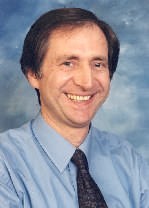2006 Hans and Marlies Zimmer International Scholar

The fourth scholar in this series is Professor Peter J. Sadler, Crum Brown Professor of Chemistry at the University of Edinburgh, Scotland. Professor Sadler received his B.A. in 1969 and M.A., D.Phil. in 1972 at the University of Oxford. He is the recipient of the Royal Society of Chemistry Award for Inorganic Biochemistry, the Dwyer Medal from the University of New South Wales Australia and is a Fellow of the Royal Society of Edinburgh. For more information on Professor Sadler, please visit his website: http://www.chem.ed.ac.uk/staff/pjsadler.html
His research interests focus on metals in biology and medicine, the design and mechanism of action of metallodrugs, especially the role of proteins in metal-induced signal transduction. His group has recently identified for the first time the major zinc binding site on human albumin, characterised the first multinuclear form of a transferrin protein, a new class of bacterial proteins involved in zinc resistance containing a novel zinc-finger in a zinc-cluster centres, a novel copper site in a bacterial copper chaperone, and has proposed a new mode of interaction of metallated anti-HIV macrocycles with the CXCR4 receptor. His work involves close collaboration with biologists, clinicians, and industry.
ABSTRACT
The Chemical Elements of Life and Medicines : A Web of Health?
There are 81 stable elements on Earth. The internet offers most of these in mineral supplements - but are they all essential for life? Is there a code in the human genome for each of the essential elements ? - and if so what kind of code is it? I will take a journey through the periodic table and attempt to identify essential elements and their codes, and emphasize that even non-essential elements (including radioactive ones) can be used in the design of therapeutic and diagnostic agents. I shall illustrate how the chemistry of metals in particular can be controlled by their oxidation states and the types and numbers of bound ligands. Inorganic chemistry has much to offer the discovery of truly novel medicines and the understanding of diseases that are currently intractable. To know chemistry, is to know life!